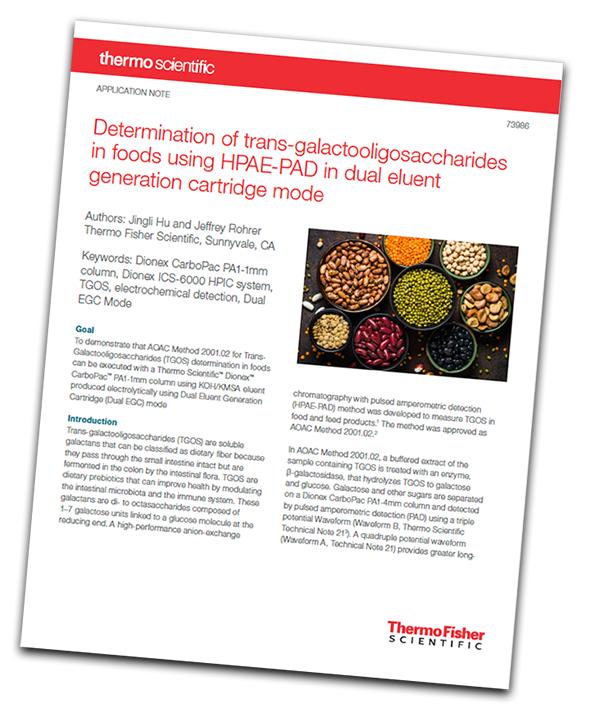This application note demonstrates that AOAC Method 2001.02 for TGOS analysis could be successfully executed with a Thermo Scientific Dionex CarboPac PA1-1mm column using HPAE-PAD in Dual EGC Mode.

 Goal
Goal
To demonstrate that AOAC Method 2001.02 for Trans-Galactooligosaccharides (TGOS) determination in foods can be executed with a Thermo Scientific™ Dionex™ CarboPac™ PA1-1mm column using KOH/KMSA eluent produced electrolytically using Dual Eluent Generation Cartridge (Dual EGC) mode.
Introduction
Trans-galactooligosaccharides (TGOS) are soluble galactans that can be classified as dietary fiber because they pass through the small intestine intact but are fermented in the colon by the intestinal flora. TGOS are dietary prebiotics that can improve health by modulating the intestinal microbiota and the immune system. These galactans are di- to octasaccharides composed of 1–7 galactose units linked to a glucose molecule at the reducing end. A high-performance anion-exchange modechromatography with pulsed amperometric detection (HPAE-PAD) method was developed to measure TGOS in food and feed products. The method was approved as AOAC Method 2001.02.
In this application note, AOAC Method 2001.02 was evaluated with a Dionex CarboPac PA1 column (250 mm × 1 mm) using HPAE-PAD in dual eluent generation cartridge (Dual EGC) mode.
Experimental
Full details of the experimental conditions can be found by downloading the application note.
Results and Discussion
Separation
The Dionex CarboPac PA1 column is a general-purpose column for HPAE-PAD methods that separate mono-, di-, and some oligosaccharides. AOAC Method 2001.02 uses a Dionex CarboPac PA1-4mm column with manually prepared sodium hydroxide/sodium acetate eluents.
Conclusion
This application note demonstrated that AOAC Method 2001.02 for TGOS analysis could be successfully executed with a Dionex CarboPac PA1-1mm column using HPAE-PAD in Dual EGC Mode. The separation, linearity, and reproducibility were excellent. Comparison with a traditional HPAE-PAD separation of TGOS using sodium hydroxide/sodium acetate eluents showed that the Dual EGC method delivers a similar resolution of carbohydrates, simplifies operation (no eluent preparation), and improves retention time precision.




